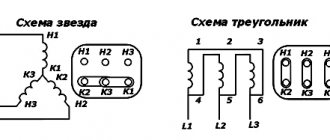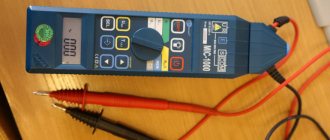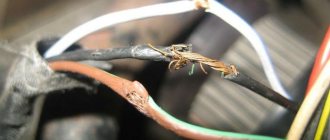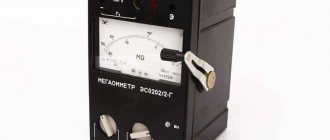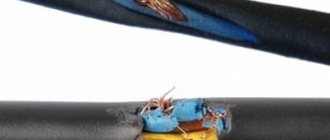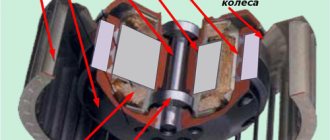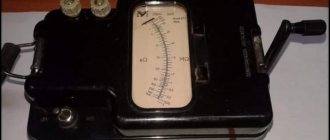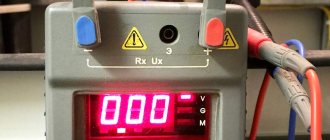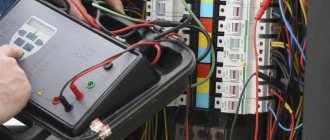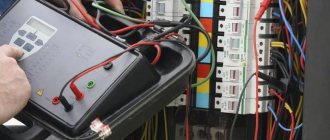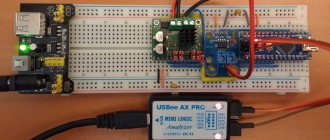About megohmmeters and megaohmmeters
Instead of a preface: Megger or megaohmmeter and measure For myself, I set the following gradation: Megger
- the brainchild of the Uman plant, region-DP and other switches, with a handle and an error of 15% (for example, ESki, Fki)
Megger
- originally an English electronic craft, with a small range measurements, for example up to 2-3 GOhm, test voltage is usually up to 1000 V - essentially a tester (Megger, Metrel, Sonel MPI-501, Chinese crafts)
Megohmmeter
- a device that can measure tens and hundreds of gigaohms (that is, a meter at 2500V) and gives specific numbers.
(E6-24, PSI-2500, MIC-2500 series) Only a megohmmeter can detect poor insulation of a motor, transformer, cable when it still seems
to be working normally, but there is already a risk that it will “shoot” if this continues.
If the insulation resistance is more than 500 kOhm, you can turn it on without drying, but it is better to control drying with a megohmmeter. And the insulation value of a serviceable motor and cable can only be obtained by it. A very useful function that is sometimes necessary is the breakdown voltage and leakage voltage at 100 mA of the arrester, but this is not directly related to the measurement of insulation resistance. However, this is my personal “expert opinion”; according to the technical documentation, everything can be measured, and with verification, everything that is above the minimum is excellent... Although what is “excellent” if the cable insulation resistance is 2-3 MOhm?!
I had a broken ES0202/2-G 2002 lying around. They said that they had plugged it under voltage, but it turned out that the display meter was mechanically broken (the top extension was torn).
I bought a display meter and stretchers on Avito, it cost 690 with delivery by mail. I recommend! But they take a long time to travel (relatively - less than a week, the post office again worked better than SDEK), and my hands were itching... Therefore, I found from an ad for 500 rubles the same non-working ES, but from 1995 in Yubileiny, I went, picked it up and assembled one of the two. And then I looked through the ads and found E6-24 for 1000 (thousand!) rubles. According to the seller's description, it is fully functional, only without an adapter and converted to a lithium battery. Sent by SDEK from the Stavropol Territory on the 9th, arrived in Mytishchi on the 14th. However, Avito delivery takes the longest, so Russian Post rules...
Source
Megaohmmeter - purpose, how to choose
A megohmmeter is a device for measuring insulation integrity.
First of all, the device is capable of measuring large resistance values. Specifically, expressed in units of megohms, which gives it its name. But it should not be confused with an ohmmeter, which also measures resistance. However, it does not have its own high voltage source.
One of the most popular megaohmmeters today is the E6-24 model. The average price of E6 24 is in the range of 24,000 – 25,000 rubles. The measurement range is from 10 kOhm to 300 GOhm.
Megaohmmeter - purpose
The device is used to test the insulation resistance of electrical circuits. For this purpose, the device generates preset test voltages. Commonly used are 100, 500, 1000 and 2500 Volts.
By the way, previously the device was called a megometer, which did not fully reveal the essence of the device. Almost all modern models use a battery-powered voltage conversion circuit. The devices can take measurements in different periods of time (1-10 minutes or more).
Typically, a megohmmeter is used to measure the insulation resistance of cables. Although the device can measure the resistance of dielectrics of wires, transformers, connectors, windings, etc. Also used for measuring volumetric and surface resistances of insulating materials.
Based on the measurements, the polarization and absorption coefficients of the material are calculated. These indicators are of great importance in work. For example, while observing safety precautions for using electrical appliances. And also to prevent insulation breakdown, equipment failure, leakage or short circuit.
Megaohmmeter: what is it, scope and principle of operation
A megohmmeter is a special meter used to measure high resistance values. The main difference from traditional ohmmeters is that measurements are carried out at a significant voltage level, independently generated by insulation meters.
The functioning of insulation resistance meters is explained by Ohm's law, which operates in a section of an electrical circuit: I=U/R. The main components installed inside the housing are represented by a voltage source having a constant and calibrated value, as well as a current meter and terminal outputs.
The connecting wires are fixed to the terminals using conventional alligator clips, and the current values of the electrical circuit are measured using the ammeter present. Some models are characterized by the presence of a scale with two types of values or numbers displayed on the screen.
Operating principle of a megohmmeter
Megohmmeters are used to measure insulation resistance, as well as to determine the insulation absorption coefficient of electrical equipment that is not under operating voltage conditions. Insulation resistance meters are classified depending on the typical features of the circuit and indication method.
Digital models are cheaper devices, while analog devices are expensive, but are distinguished by high accuracy of measurements. The main area of application is currently represented by production and distribution systems of electrical energy, control systems for the operation of electrical equipment in industry, laboratories and in the field. In everyday life, such devices are not in great demand.
Megaohmmeter - how to choose?
Measuring insulation with a megohmmeter is a necessary procedure. For this reason, almost all industries should take care of purchasing a megohmmeter. Especially those who have a full-time electrician and use voltages over 500V for equipment.
Of course, you can buy any megaohmmeter in an online store. But before purchasing, it is better to familiarize yourself with several principles for choosing a device. When choosing, you should consider:
Insulating materials can have different resistances. However, there is a nominal resistance that certain insulating materials must meet. For example:
The device should be selected according to the specified parameters. As a rule, work with a megohmmeter should be carried out by a specialist. However, once a year the megohmmeter must be verified. In particular, to identify errors and the possibility of further operation of the device.
Source
Currently, on the market of measuring instruments, there are many different megohmmeters , or, as they are also called, insulation resistance meters. They all differ in their parameters, as well as in their price category. We have prepared this table for you to make choosing a megohmmeter a little easier. The table is compiled from the main technical characteristics. Let's look at each of them.
The test voltage generated by the device can vary from 50 to 10,000 volts. The only megohmmeter that covers the entire range of test voltages is MI 3200 . Other devices generate a certain voltage range.
The principle of generating test voltage : megohmmeters : - With a built-in mechanical generator
— Battery powered
-Battery power supply.
All types have both their pros and cons. Let's look at them:
Megaohmmeters with a built-in generator have a big advantage, such as operation at very low temperatures and for any amount of time, because voltage is generated manually. The disadvantage of this type of power supply is the accuracy of the measurement; rotating the generator handle at the same speed will make it difficult to maintain a stable voltage.
When using battery-powered megohmmeter, The disadvantage of this power supply is the constant need for batteries (AA batteries can be replaced) and poor performance at negative temperatures.
Battery power supply – high-capacity batteries supplied with the megohmmeter are used. One of the advantages is that it can work in autonomous mode for quite a long time; there is no need to constantly buy additional AA batteries. Cons: poor performance at sub-zero temperatures, need to be charged from an industrial network from time to time.
Measuring range of megohmmeters: The measuring range depends on the voltage. The higher the voltage that the megohmmeter , the greater the resistance the device can measure. Measurements range from 0 ohm to 10 tom.
Information output: There are two types of information output. Analog (A) and Digital (D).
Additional functions of the megohmmeter: There are several of them, but in our table we included only two functions - Measurement of absorption coefficient (DAR) and polymerization coefficient (PI), as well as communication with a PC
Megaohmmeter price: The price of the device depends on the parameters of the device itself. The higher the parameters, the higher the price.
order megaohmmeters by calling or sending us a request by email: This email address is being protected from spambots. Javascript must be enabled in your browser to view the address. You can also find out more about placing an order on our website.
Source
Which megohmmeter is better to choose?
To protect people from electric shock when the insulation in consumer electrical installations is damaged, periodic monitoring of the insulation condition of electrical wiring, cables, electrical installations, etc. is necessary.
Insulation resistance and absorption coefficient are measured using a megohmmeter (megohmmeter).
A megohmmeter is a device that measures the direct current resistance of insulation. Until recently, the source of direct current was a generator with permanent magnets built into the megohmmeter, rotated by hand or by an electric drive. With the development of technology, digital megohmmeters began to be equipped with electronic converters, powered by an adapter or battery (for example, TsS0202, etc.), which led to a reduction in the size of the device.
Which megaohmmeter should you choose? The choice of megohmmeter type can be divided into several criteria.
APPLICATION
EASY TO USE
What type of display: pointer dial (ES0202, ES0210, M419, F4106), digital liquid crystal (TSS0202) or LED display, auxiliary devices: backlight, equipment (all megohmmeters from the Uman Megohmmeter plant).
OPERATING MODE
What are the climatic operating conditions (TSS0202-2 for the north)?
Should this device always be at hand?
Power source: magnetic-electric generator (available only in megohmmeters produced by the Uman Megohmmeter plant), rechargeable battery, battery?
What other measurements will need to be performed: current, voltage, absorption coefficient (TsS0202 measures)?
We recommend:
One of the main types of protection is the use of various types of insulation of live parts. The simplest, but very effective method of monitoring its condition is to measure the insulation resistance using a megohmmeter.
With this method of assessing the quality of insulation, the reliability of the readings comes to the fore, which consists of the basic error of the device, its resolution and additional error due to ambient temperature, humidity, etc., and for devices with dial indication also the parallax error vision.
Digital megohmmeters TsS0202-1 and TsS0202-2 developed and produced by Umansky measure the voltage at the facility, insulation resistance, and calculate the absorption coefficient. Megaohmmeters TsS0202-1 and TsS0202-2 automatically remember the last 10 values of RХ, R60 and R15, and also calculate the absorption coefficient.
All these parameters in the TsS0202-1 and TsS0202-2 megohmmeters can be displayed on the display by pressing one button. A wide operating temperature range (-30°C to +55°C) is achieved through the use of a vacuum-illuminescent display. All this will allow you to obtain reliable readings in almost any operating conditions.
The TsS0202-1 and TsS0202-2 devices are powered from a rechargeable battery, or from an alternating current network through an adapter, which also serves to charge the battery. Megohm meters TsS0202-1 and TsS0202-2 are equipped with a battery condition monitoring system. The built-in stabilizer protects the battery from overcharging. Also, the TsS0202-1 and TsS0202-2 megaohmmeters automatically switch to energy-saving mode 1 minute after the end of measurements (inactivity).
TsS0202 megohmmeters have better performance in most parameters compared to the E6-24 and E6-24/1 megohmmeters that appeared on the Russian market.
Comparative table of technical characteristics of TsS0202-2 and E6-24/1, E6-24:
Source
Design and principle of operation
The question of how to test a cable with a megohmmeter arises due to the impossibility of correctly measuring this indicator using a conventional multimeter. The latter does not make it possible to assess the presence of damage to the cable insulating layer and violations of its integrity: even in the case of a sufficiently high rated voltage, the leakage current is too small to be measured with a multimeter.
A megohmmeter makes it possible to determine the resistance of the insulating material separating cable cores, electric motor windings, and other structures in power tools.
Important! These devices are available in different versions. To choose which meter to purchase, you should rely on the features of their functioning, as well as take into account estimates and prices
Electromechanical megohmmeter
This is the earliest configuration of this device. It includes a current generator powered by rotating a handle, a resistance, an ammeter with a scale, as well as terminals to which the wiring is connected when determining the required parameters: grounding, line and screen. The apparatus can be described as having a simple design and not depending on external current sources. There are also a number of disadvantages: high scale error, the need to keep the instrument body motionless in order to obtain the most accurate measurements.
Electronic megohmmeter
In such devices, the test voltage is generated by an electrical circuit, and measurement is carried out using an analog type meter. This way you can check the resistance without having to turn the knob. It also allows you to measure the absorption index, which describes the moisture content of the insulating material.
Microprocessor megohmmeters
The main advantages of such devices are their compact design and the presence of a digital display. This allows you to combine different functions (assessment of grounding resistance, phase-neutral loop, and others) in one case, which eliminates the need to carry many devices with you.
User manual
The insulation resistance is checked on de-energized equipment or cable lines or electrical wiring. Remember that the device generates high voltage and if the safety precautions for using a megohmmeter are violated, electrical injuries are possible, because Measuring the insulation of a capacitor or long cable line can cause a dangerous charge to accumulate. Therefore, the test is carried out by a team of two people who have an understanding of the dangers of electric current and have received safety clearance. During testing of the object, no unauthorized persons should be nearby. Remember about high voltage.
Each time the device is used, it is inspected for integrity, for the absence of chips and damaged insulation on the measuring probes. Trial testing is carried out by testing with open and closed probes. If tests are carried out with a mechanical device, then it must be placed on a horizontal, flat surface so that there is no error in the measurements. When measuring insulation resistance with an old-style megohmmeter, you need to rotate the generator handle at a constant frequency, approximately 120-140 rpm.
If you measure resistance relative to the body or ground, two probes are used. When testing the cable cores relative to each other, you need to use the “E” terminal of the megohmmeter and the cable screen to compensate for leakage currents.
Insulation resistance does not have a constant value and largely depends on external factors, so it can vary during measurement. The check is carried out for at least 60 seconds, starting from 15 seconds the readings are recorded.
For household networks, tests are carried out with a voltage of 500 volts. Industrial networks and devices are tested with voltages in the range of 1000-2000 volts. You need to find out exactly what measurement limit to use in the operating instructions. The minimum permissible resistance value for networks up to 1000 volts is 0.5 MOhm. For industrial devices, no less than 1 MOhm.
As for the measurement technology itself, you need to use a megohmmeter according to the method described below. As an example, we took the situation with measuring insulation in a switchboard (power panel). So, the procedure is as follows:
We remove people from the part of the electrical installation being tested. We warn about the danger and post warning posters. We remove the voltage, completely de-energize the shield and input cable, and take measures against erroneous voltage supply. We hang up a poster - DO NOT TURN ON, PEOPLE ARE WORKING. We check that there is no voltage. Having previously grounded the terminals of the test object, we install the measuring probes, as shown in the megohmmeter connection diagram, and also remove the grounding. This procedure is carried out with each new measurement, since nearby elements can accumulate a charge, introduce an error in the readings and pose a danger to life. Installation and removal of probes is carried out using insulated handles while wearing rubber gloves.
Please note that the insulating layer of the cable must be cleaned of dust and dirt before checking the resistance.
We check the insulation of the input cable between phases A-B, B-C, C-A, A-PEN, B-PEN, C-PEN. The results are recorded in the measurement protocol
We turn off all automatic devices, RCDs, turn off lamps and lighting fixtures, disconnect the neutral wires from the neutral terminal. We measure each line between phase and N, phase and PE, N and PE. The results are entered into the measurement protocol. If a defect is detected, we disassemble the measured part into its component elements, look for the fault and fix it.
At the end of the test, we use portable grounding to remove the residual charge from the object, by short-circuiting, and from the measuring device itself, discharging the probes among themselves. According to these instructions, you need to use a megohmmeter when measuring the insulation resistance of cable and other lines. To make the information more clear to you, below we have provided videos that clearly demonstrate the order of measurements when working with certain models of devices.
Megaohmmeter. Types and device. Operation and Application
Electrical resistance can be measured with various instruments. The megohmmeter has become the most popular among such devices. Judging by the name of the device, it can be determined that its unit of measurement is megaohms. It is primarily used to measure large resistance values, electrical circuits , and dielectric insulation used for cables, wires , electric motors , transformers and other electrical installations.
To use a megohmmeter in work, you must first study its operating principle, design and technical parameters, since there are specific features when using such a device.
Kinds
There are two main types of megohmmeters, differing in the type of power source and measurement method.
Analog
Such devices are also called pointer devices. They have an individual dynamo, which is activated by turning the handle, as well as a graduated scale with a dial indicator. The measurement is carried out based on the magnetoelectric principle. The pointer is fixed on the same axis with a frame coil located in the magnetic field of a permanent magnet.
When current flows through the coil, it deflects by a certain angle, depending on the magnitude of the current flowing. This action occurs according to the law of electromagnetic induction. The pointer megohmmeter is unpretentious in operation, reliable, although it is considered an outdated device, has a large mass and significant overall dimensions.
Digital
Modern digital megohmmeters have a built-in powerful pulse generator operating on field-effect transistors . Such devices are equipped with an individual power source, in the form of an AC adapter that converts alternating current to direct current, or a rechargeable battery . The measurement is performed by a special amplifier by comparing the voltage drop in the circuit under test with a reference resistance.
The measurement results are displayed on a digital screen. It is possible to save the results in memory for future data comparison. The electronic megohmmeter is lightweight and small in size, allowing you to make many different electrical measurements. However, to work with such a device, highly qualified personnel are required.
Operating principle and device
The operation of a megohmmeter is to use Ohm's law , which is described by the formula: I = U / R , where I is the current, U is the voltage, and R is the resistance. The device of this device includes a calibrated voltage source, an ammeter and terminals to which special measuring probes are connected.
Older analog instruments have conventional hand-held generators with a crank to operate them, while newer models use external or internal power sources in the form of a battery or power supply. The amount of power at the generator output and the voltage can vary over a wide range, or be constant, depending on the design of the device. The megaohmmeter kit includes measuring probes, which consist of wires with tips: on one end of the probe there is a tip for insertion into the device socket, and on the other there is a “crocodile” for reliable contact.
Before measurement, the probes are inserted into the sockets on the device, then connected with crocodile clips to the object being measured. When performing a measurement, the generator generates high voltage by rotating the handle. Voltage is supplied to the object being measured, and the measurement results are displayed on the screen of a digital device or on the scale of a pointer megohmmeter.
How to use a megohmmeter correctly
During operation, the device produces high voltage that is dangerous to humans - from 500 to 2500 volts. Therefore, the use of the device must be approached with extreme caution. In industrial production, persons with an electrical safety group of at least third are allowed to work with it.
Before taking measurements, the circuits being tested should be de-energized. If measurements are planned to be made in an apartment, then you should turn off the circuit breakers in the distribution board, then turn off all connected devices in the apartment.
If groups of sockets are checked, then all inserted device plugs should be removed from them. When checking lighting circuits, it is necessary to unscrew the light bulbs, since they are not designed for such high voltage and can burn out. When testing the insulation of electric motors, they should also be disconnected from the network.
Next, the circuits being tested should be grounded. To do this, a stranded wire in insulation with a cross-section of more than 1.5 mm 2 is connected to the grounding bus, which is portable grounding.
Safety requirements
Even if you use a megohmmeter at home, before work you should study the requirements for safe work practices.
There are several basic rules:
- Probes should only be held by insulated handles limited by stops.
- Before connecting the probes to the circuit being measured, you should make sure that the voltage supply to the device is turned off and that there are no people near the line being measured who could accidentally become energized.
- The next step is to remove the residual voltage by touching a portable ground to the circuit being measured. Grounding is turned off only after installing the probes.
- After each measurement, it is necessary to remove residual voltage from the probes by connecting the probes to each other.
- After the measurement, grounding should be connected to the tested conductor to remove the residual charge.
- All work must be done with rubber gloves.
These simple rules must be followed, since the safety of people depends on it.
Rules for connecting probes
There are three sockets on the device body. They are designated by the symbols “ E ”, “ L ” and “ Z ”, which means screen, line and ground, respectively. The megaohmmeter kit contains three probes. On one of them, two tips are connected on one side. This probe is used when it is necessary to exclude leakage current, and is connected to the shielded sheath of the cable, if available. The remaining probes are inserted into the sockets corresponding to the markings of the probes with the same letters.
SAFETY INSTRUCTIONS FOR WORKING WITH A MEGGER.
At numerous requests from our customers, we have developed and published “Safety Instructions for Working with a Megger.” We believe that such instructions, or similar ones, should be in every enterprise that uses a megohmmeter in their work.
1. General safety requirements.
1.1. All work that is carried out using a megohmmeter in existing electrical installations must be carried out according to an order or order drawn up in writing. 1.2 To carry out work on measuring insulation resistance with a megohmmeter in existing electrical installations above 1000 V, it must be carried out by at least two workers: one with group IV, the other with group III .Measurement of insulation resistance with a megohmmeter in electrical installations up to 1000 V and in inactive electrical installations is allowed to be carried out by one worker with group III.
1.3. Conductors used to connect the megger to live parts must be certified and have appropriate insulation and insulating holders to ensure the safety of measurements.
1.4. When measuring insulation resistance, the megger must be installed on a solid insulated support. 1.5 The worker carrying out measurements with the megger must know the safety instructions and operating instructions for the device.
1.6. It is prohibited to take measurements with a megger: 1.6.1. if one of the circuits of double-circuit lines has a voltage above 1000 V, if the second circuit is energized;
1.6.2. on a single-circuit line, if it runs in parallel with a working line with a voltage above 1000 V; 1.6.3. during a thunderstorm or as it approaches.
2.Safety requirements before starting work.
2.2. If necessary, remove the charge from live parts by first grounding them.
2.3.Connect the megohmmeter to live parts using connecting wires with insulating holders. In electrical installations above 1000 V, in addition, it is necessary to use dielectric gloves or mats.
2.4 Before starting measurements, make sure that there are no people working on that part of the electrical installation to which the megohmmeter is connected, and also prohibit those nearby from touching live parts, and if necessary, set up security.
3.Safety requirements when taking measurements with a megger.
3.1.When working with a megger, you must follow the operating instructions for the megger and strictly follow the sequence of actions when taking measurements.
3.2. It is prohibited to touch the megger terminals and live parts to which it is connected.
3.3. The use of non-certified conductors and clamps used when taking measurements with a megger is prohibited.
3.4. After carrying out measurements with a megger, it is necessary to remove the residual charge from current-carrying parts by briefly grounding them. The worker grounding live parts must wear dielectric gloves, safety glasses and stand on an insulating base.
When putting a cable into operation, during and after repair work, in case of problems with wiring - in all these cases it is necessary to check the condition of the cable insulation. A regular multimeter can only indicate that there is a problem. And its specific scale can only be determined using a special device - a multimeter. This device is classified as professional, but modern devices can have several functions (measurement of other parameters of electrical networks). So some owners of houses, cottages, and garages prefer to have their own. How to take measurements, how to use a megohmmeter, and we’ll talk further.
How to use the device
When the handle of a hand-held device is rotated or as a result of pressing a button on electronic devices, high voltages are supplied to the terminal outputs, which are supplied through wires to the electrical circuit being measured or to the electrical equipment. When taking measurements, resistance values are displayed on the scale or screen.
Table: megohmmeter parameters during measurements
| Element | Minimum insulation resistance | Meter voltage | Peculiarities |
| Electrical products and devices with a voltage level within 50 V | Correspond to the passport data, but not less than 0.5 MOhm | 100 V | During measurements, semiconductors are efficiently shunted |
| Electrical products and devices with voltage levels in the range of 50–100V | 250V | ||
| Electrical products and devices with voltage levels in the range of 100–380V | 500–1000V | ||
| Electrical products and devices with voltage levels in the range of 380–1000V | 1000–2500V | ||
| Distribution devices, electrical panels and current wires | Not less than 1 MOhm | 1000–2500V | Each section in the switchgear is measured |
| Electrical wiring, including lighting networks | Not less than 0.5 MOhm | 1000V | Inside hazardous areas, measurements are carried out annually, in others - every three years. |
| Stationary electric stoves | Not less than 1 MOhm | 1000V | Measurements are carried out on heated and switched off stoves annually |
Safety rules when working with the device
Modern megohmmeters generate a voltage level within 2500 V, so only workers who have completed a full course of special training and are familiar with safety regulations can perform work with such a device. Only fully functional and verified measuring instruments may be used in the work. Measurements on short-circuited wires show the magnitude of the insulation resistance.
On older resistance meters, this value is equal to “infinity”.
Be sure to study the safety rules when working with the device
When operating an electronic device equipped with a modern digital display, the measurement indicators are always fixed.
- When performing insulation resistance measurements, any touching of the output terminals of the measuring device and contact with the bare parts of the connecting wires in the form of the ends of the probe are strictly prohibited. Do not touch bare metal parts of the electrical circuit being measured in equipment under high voltage.
- It is strictly prohibited to measure insulation resistance without checking the absence of voltage if measures are planned with the conductors of the electric cable or with any live parts of electrical installations. Checking for the presence or absence of voltage in wires and installations is carried out using an indicator, a special tester or a voltage indicator.
- Measurement activities are prohibited if there is a residual charge on electrical equipment. To remove the residual charge, an insulating rod or grounding with a short-term connection to the current-carrying sections of the device must be used. The residual charge is eliminated after all measurements have been carried out.
The use of a megohmmeter that has undergone inspection and standard testing is possible only after its performance has been confirmed. It is necessary to verify the correct operation of such a measuring device immediately before measuring the insulation resistance. For this purpose, connecting wires are connected to the output terminals, after which a wire short-circuit is performed, which allows you to begin measurements. It should be remembered that in conditions of shorted wires, the resistance readings should be zero, and shorted connecting wires allow you to verify their integrity.
How to connect a megohmmeter?
For each model of devices for this purpose, the output voltage value is determined, so in order to effectively test the insulation or measure its resistance, you need to choose the right megohmmeter.
Watch this video on YouTube
To check the cable insulation with a megohmmeter, a so-called extreme case is created, in which a voltage higher than the rated one is applied to the test section, but within the permissible standards specified in the technical documentation.
For example: a megohmmeter generator can produce:
Accordingly, the voltage supply should be an order of magnitude greater.
The duration of the measurement process usually does not exceed 30 seconds or minutes; this is necessary for more accurate detection of defects, as well as to eliminate their subsequent appearance during voltage surges in the network.
The basis of the technological process of measuring resistance is: preparation for the process, its implementation and the final stage. Each of them includes a certain list of manipulations necessary to achieve the goal without harm to others and, first of all, to oneself.
When preparing for work, you should organize your actions, study the electrical installation diagram to eliminate possible breakdowns, and also ensure your safety.
When starting work, you should first check the device for serviceability. To do this, the leads are connected to the measuring leads. Then their ends are connected to each other in an attempt to short-circuit. After applying voltage, the measurement readings are taken (they should be equal to zero). The next stage involves re-measuring. If there are no malfunctions, the reading should differ from the previous one.
Then they connect the portable grounding to the earth circuit, check and ensure that there is no voltage in the area, install the portable grounding, assemble the measuring circuit of the device, remove the portable voltage, remove the residual charge, disconnect the connecting wire, remove the portable voltage.
The final stage involves restoring the disassembled circuits, removing shunts and short circuits, as well as preparing the circuit for operating mode. The obtained results of measuring the resistance of the insulating layer are documented in the insulation verification report.
Taking measurements
After successfully solving all the problems, you can try to measure the wiring with a megameter. After successfully installing the probes, you should decide on the test voltage. When checking the insulation resistance, you need to apply a voltage of 500-1000 V, following the following instructions:
- First of all, it is necessary to prepare the object for measurements.
- Then you need to install a portable ground and move the switch to the desired position. You should also choose a measurement scale, taking into account the resistance value.
- You need to check the absence of voltage on the line using an indicator screwdriver or a multimeter, and then connect the probes to the measurement objects.
- All that remains is to remove the portable grounding and start taking measurements. If the work is carried out using an electronic device, then you need to press the “test” button on it. In manual models, you will have to turn the dynamo handle until the signal lamp lights up (this will confirm that the test voltage has been created).
- Having recorded the results obtained, all that remains is to disconnect the probes and take the residual voltage readings on the megohmmeter and the line.
If the indicators drop below a given level, you will have to act in two ways: either find the cause of the breakdown and eliminate it, or replace it.
Where is it used?
Insulation, like any material, deteriorates and wears out over time and due to weather conditions. To promptly detect an insulation defect, a megohmmeter is used. It is needed to measure the insulation resistance of a power cable, electrical connector, transformer interwinding, or electrical machine. It is also necessary to measure surface and bulk dielectrics. The advantage of the device is complete autonomy, independence from power sources and automatic calculation of the absorption and resistor processes.
Application in industrial conditions as the main area
Insulation resistance: how to measure correctly
Before measuring resistance, you need to carefully study the electrical installation diagram, prepare protective equipment and the device itself is in good condition. The area being tested must be taken out of operation in advance.
Checking the serviceability of the megohmmeter is as follows. The test leads are shorted together. After this, voltage is supplied to them from the generator. If the device is working properly, the measurement results of the shorted circuit are zero. Next, the ends of the wires are disconnected, moved to the sides, after which a repeat measurement is made. Normally, the scale displays an infinity symbol, indicating the insulation resistance in the air gap between the measuring ends.
Direct measurement of insulation resistance is performed in a strictly defined sequence. First of all, the portable ground must be connected to the circuit. There should be no voltage in the area being tested. Next, the measuring circuit of the device is assembled, and the portable grounding is removed.
A calibrated voltage is applied to the circuit until the capacitive charge is equalized. Next, the countdown is recorded, after which the voltage is removed. To remove the residual charge, a portable grounding is applied. At the end of the measurements, the connecting wire is disconnected from the circuit, and the grounding is removed.
To measure insulation resistance with a megohmmeter, the highest MΩ limit is used. If this value is not enough, you need to use a more accurate range. All further chains of measurements must be performed in the same sequence. Some megaohmmeter designs can operate in intermittent mode. In this case, voltage is applied for one minute, after which there is a pause for two minutes.
If there is a dial indicator in the measuring instruments, the horizontal orientation of the body is used for all measurements. Violation of this requirement leads to additional errors. Modern digital megohmmeters can operate in any position.
Measuring insulation resistance with a megohmmeter
How to use a multimeter step by step instructions
How to use a voltmeter
How to use a multimeter
Measuring the insulation resistance of electrical wiring
How to use a megger
Danger of high voltages
The built-in generator is characterized by output power indicators that are enough not only to assess the condition of the insulation, but also to cause a serious burn. Because of this feature, only trained electrical technicians with at least group 3 access to such devices are allowed to use the device.
When taking measurements using increased voltage, you need to cover the area being tested, terminals and wires. To ensure protection, probes with characteristic insulation are used. On one side they are fixed to the wires, and the other part is equipped with safety rings. As a result, it prevents you from touching exposed areas and prevents possible electric shock.
To carry out measurements, such devices provide a special working area that does not conduct current and is a safe place to hold. To connect to the circuit, use an alligator clip with good insulation. Any other wires or stand-alone probes are not allowed. In addition, to increase the safety of the procedure, the area being tested must be isolated from strangers. This is especially important when checking resistance in long cables with a length of up to several kilometers.
As for the induced voltage , it plays a significant role in the accuracy of the measurements. Electricity that passes through power transmission line wires is capable of creating a certain magnetic field, measured taking into account the sinusoidal law. If the cable has an impressive length, this voltage becomes very high.
Depending on this factor, the measurement accuracy varies significantly. This is explained by the fact that the magnitude and direction of the current passing through the device remain unknown. It occurs under the influence of induced voltage, and its indicators appear near the device’s own readings. As a result, the sum of two current quantities is displayed on the digital screen, and the task remains unsolved. Therefore, measuring insulation resistance in the presence of any type of voltage is a waste of time and effort.
You might be interested in the principle of operation, purpose and scope of application of triggers
Device and principle of operation
A megohmmeter is a device for checking insulation resistance. There are two types of devices - electronic and pointer. Regardless of the type, any megohmmeter consists of:
Probes, through which voltage from the device is transmitted to the object being measured.
In pointer instruments, the voltage is generated by a dynamo built into the housing. It is driven by a meter - it rotates the handle of the device with a certain frequency (2 revolutions per second). Electronic models take power from the mains, but can also run on batteries.
The operation of the megohmmeter is based on Ohm's law: I=U/R. The device measures the current that flows between two connected objects (two cable cores, core-ground, etc.). Measurements are made with a calibrated voltage, the value of which is known; knowing the current and voltage, you can find the resistance: R=U/I, which is what the device does.
Approximate diagram of a magaohmmeter
Before testing, the probes are installed in the appropriate sockets on the device, and then connected to the object being measured. During testing, a high voltage is generated in the device, which is transmitted to the object being tested using probes. Measurement results are displayed in mega ohms (MΩ) on a scale or screen.
Operating principle of a megohmmeter
The operation of the megohmmeter is based on Ohm's law for a section of the circuit, displayed as the formula I=U/R. For measurement, elements located in the device body are required. First of all, it is a voltage source with a constant, calibrated value. In addition, the megohmmeter is complemented by a current meter and output terminals.
In different models, the design of the voltage source can vary significantly. Older megohmmeters use simple hand-held dynamos, while newer ones use external or built-in sources. The value of the generator output power and its voltage can change in different ranges or remain fixed. Connecting wires are connected to the terminals of the megohmmeter and connected into the circuit being measured. Reliable contact is ensured by crocodile clips.
An ammeter included in an electrical circuit measures the amount of current passing through the circuit. Thanks to the precise voltage value, the scale on the measuring head is immediately marked in the required resistance units. These can be mega-ohms or kilo-ohms. Some devices are equipped with a scale showing both values. New models of megaohmmeters that use digital signals display the received data on a display.
Measurements with a megohmmeter
When starting to check the cable insulation with a megohmmeter, you need to determine what type of wire you are testing. The description of the sequence of work for different types of cables is similar, but for each group there are certain nuances.
Measuring high voltage lines
This includes wires with voltages of more than a thousand volts. According to standards, the insulation of such products must have a resistance exceeding 1000 MOhm. The device used for measurements must be designed for 2500 V (similarly for low-voltage cables).
Testing of low voltage cables
For such cables, the indicator should be at least 0.5 MOhm. First, the device is placed between the phase conductors, then - between the phases and zero, after that (if the wire has five conductors) - between the phases and grounding, at the very end - between the grounding and neutral conductors (the latter must be disconnected from the bus before this).
Testing of control cable systems
Devices of 500-2500 V are used here. The final result should be more than 1 MOhm. The output of the device is placed on one core, the remaining ones are connected and placed on the ground. The second output is placed on any core that is not subject to measurement at the moment. Having made the measurements, the vein is placed with the others and the next one begins to be tested.
Preparing for work
Before you check the resistance of any cable, you must make sure that there is no voltage on it. For high-voltage lines, a high-voltage indicator is used, for low-voltage lines, protective means are used for manipulations in electrical installations. Warning posters must also be posted.
Line connection
The standard package includes three probes with different characteristics and structures. One of them has two tips and is designed to combat leakage currents. On the top side of the device there are three sockets for connecting probes. Each of them is characterized by a corresponding letter marking:
- Z - for connecting protection grounding.
- L is the line that is being measured.
- E - screen (intended to eliminate leakage currents).
You might be interested in Description and types of input distribution devices (IDUs)
There are no other options, except for cases with shielded wiring. However, in private buildings such methods are not used, since the installation of cables with a screen is practically useless here. However, if you have this type of cable, you need to minimize the risk of leakage currents by using a probe with a split end. The wires of the shielding braid must be twisted into a bundle, adding to the general bundle of wires.
Measuring cable insulation resistance with a megohmmeter
The procedure is as follows (CABLE DE-energized):
If we have a three-core cable, then we must obtain the phase-to-zero and phase-to-phase insulation resistance values. Total 6 measurements. In reality, they do not make three measurements, but one - they combine three wires and apply voltage from the megohmmeter to them. If the insulation resistance value is satisfactory, then everything is fine. If Rx is unsatisfactory, then each core is measured separately.
Record readings at 15 and 60 seconds to determine the absorption coefficient (Ka). This coefficient is numerically equal to the ratio of resistance values R60/R15. Shows the degree of moisture. There is also the concept of polarization coefficient or polarization index (PI) - it is equal to the ratio R600/R60 and characterizes the degree of aging of the insulation. The standards define the following values:
The limit value indicates that the cable is unsuitable for use. The polarization index is measured on cables with impregnated paper insulation along with Ka. For cables with plastic, PVC, or cross-linked polyethylene insulation, there is no need to determine the polarization index.
Now there are various digital and electronic megohmmeters. In digital ones you can immediately see after measuring the values of the absorption coefficient, R60, R15; separate devices allow you to measure PI. In addition, for sonel models you can press the start button, then use another button to lock it and not hold your finger on the button for a minute. The devices operate on batteries. It makes life easier.
In pointer instruments, the source of constant voltage (and tests with a megohmmeter are tests with constant voltage) is based on either a generator or a button (ESO models).
Here you will either have to turn the handle of the device at a speed of 2 rps, or look for an outlet. And besides this, you still need to count down the stopwatch and record the results. The scales of individual instruments also cause difficulties. But megaohmmeters from various manufacturers are the topic of a separate large article.
In general, do not forget to discharge the cable after testing, removing the accumulated charge by grounding. And only then remove the end of the device from the core being tested. And the longer the cable, the longer you keep it grounded.
Cable insulation resistance measurement
The insulation resistance of electrical wiring is measured at two points in the electrical installation, which characterize leakage when voltage is applied to the network. The result is an indicator expressed in megaohms. The measurement is carried out using a megohmmeter, which examines the current leakage that occurs when regularly supplied voltage to an electrical installation.
Modern megohmmeters provide different voltage levels to test different equipment. As a result, a mandatory part of testing a circuit is studying the insulation resistance.
The principle of measuring the indicator
Measuring the insulation of an asynchronous motor with a megohmmeter
Before measurements, turn off the power and remove the residual voltage. Then you need to gain access to the winding terminals. We attach one dipstick to the engine body. Make sure that the contact is with clean metal - you need to find an area without paint or rust. When checking, we connect the second probe to each of the windings (you also need to make sure that it is clean under the “crocodile”.
According to the table, asynchronous motors connected to a 220 V or 380 V network are tested at a voltage of 500 V.
Types of testers
When operating electrical devices, digital megohmmeters of the model: F4101/4102 from 100.0 to 1000.0 V are widely used. Installers still work with tester brands M4100/1, 4100/5 and MS-05 m from 100.0 to 2500.0 V. The choice of megger size is based on rated resistance of the device under test: power cables and transformers, machines and insulators. To determine the state of insulation in electrical installations up to 1000.0 V, it is allowed to use megohmmeters from 100.0-1000.0 V, and in installations over 1000.0 V - 1000.0-2500.0 V.
Devices are also classified by the voltage generated and resistance limits in megohms:
Additional Information. The devices also differ in accuracy classes. The popular M4100 model has an error of no more than 1%, and the F4101 brand has an error of up to 2.5%. The selection of electrical installation testing devices is carried out taking into account acceptable performance indicators.
Electronic meter
Electronic meter
A digital or electronic tester is a modern type of equipment, equipped with a powerful generator with field-effect transistors. Measurements are made by comparing the voltage drop in a reference circuit with a fixed resistance. The results are shown on the panel. The test results saving function accumulates data for subsequent analysis. This model differs from analog devices in its compact size and light weight. Advantages of a digital tester:
Disadvantages of the electronic type megger:
Electromechanical meter
